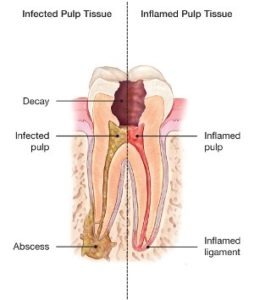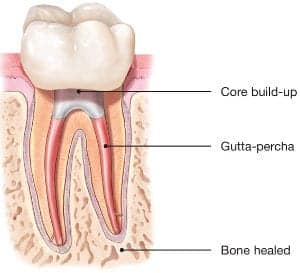Have you ever heard of a root canal treatment? It’s a dental procedure that involves removing inflamed or infected pulp from the inside of a tooth, cleaning and disinfecting it, and then filling and sealing it. Root canal treatment is designed to eliminate bacteria, prevent reinfection, and ultimately save your natural tooth. Contrary to popular belief, getting a root canal is not as daunting as it sounds. In fact, it’s a relatively painless procedure that can be completed in a few appointments, depending on your situation. And the best part? You’ll be able to return to normal activities, like chewing and biting, in no time. In this article, we’ll explore the benefits of root canal treatment and debunk some common myths associated with it.
What is a Root Canal?
A root canal treatment is a dental procedure that involves removing the inflamed or infected pulp from the inside of a tooth. The pulp is carefully cleaned, disinfected, and then filled and sealed to prevent reinfection. The purpose of a root canal treatment is to eliminate bacteria, relieve pain, and save the natural tooth.

This image is property of www.aae.org.
Reasons for Root Canal Treatment
There are several reasons why a root canal treatment may be necessary. One common reason is deep decay that has reached the pulp of the tooth. Infection or inflammation of the pulp can also occur due to repeated dental procedures, faulty crowns, or cracks or chips in the tooth. Trauma to the tooth, even without visible damage, can also lead to pulp damage.

This image is property of www.aae.org.
Benefits of Root Canal Treatment
Root canal treatment offers several benefits that make it a valuable option for saving a tooth.
Efficient Chewing
By removing the infected or inflamed pulp and restoring the tooth, root canal treatment allows for efficient chewing. It eliminates pain or sensitivity that may have been causing discomfort while eating.
Normal Biting Force and Sensation
With a successful root canal treatment, the tooth is restored and can withstand normal biting force and provide proper sensation. This means you can comfortably bite and chew without worrying about any discomfort or limitations.
Natural Appearance
Root canal treatment helps save the natural tooth, which contributes to a more natural appearance. The restored tooth blends in seamlessly with the surrounding teeth, ensuring a confident and aesthetically pleasing smile.
Protects Other Teeth from Excessive Wear or Strain
A missing tooth can lead to excessive wear or strain on the remaining teeth, as they have to compensate for the lost tooth. By saving the natural tooth with root canal treatment, this issue is avoided, and the overall health and function of the mouth are preserved.

This image is property of 1.bp.blogspot.com.
Root Canal vs Extraction
When faced with a damaged or infected tooth, you may wonder whether a root canal or tooth extraction is the best solution. In many cases, root canal treatment is the preferred option because it allows for the preservation of the natural tooth.
Root canal treatment has a higher success rate and is generally less invasive compared to extraction. It eliminates the need for tooth replacement options like implants or bridges, which can be more costly and require additional procedures.

This image is property of image.isu.pub.
Other Endodontic Treatment Options
In some cases, root canal treatment may not be suitable or sufficient to address the dental issue at hand. In such situations, there are alternative endodontic treatment options available.
One such option is endodontic retreatment, which involves redoing a previous root canal treatment that may not have been completely successful. This procedure allows for the re-treatment of the tooth to address any persistent infection or inflammation.
Another option is endodontic surgery, which involves accessing the root of the tooth directly to remove infected tissue or address other issues not reachable through conventional root canal treatment. Endodontic surgery may be necessary in cases where there is a root fracture or when infection persists after initial treatment.

This image is property of medinirvana.com.
Endodontic Surgery
Endodontic surgery is a specialized procedure performed by an endodontist to address specific conditions or issues that cannot be resolved with conventional root canal treatment. It is typically performed when the infected or inflamed tissue cannot be reached or adequately treated through other means.
One common type of endodontic surgery is an apicoectomy, also known as root-end resection. This procedure involves removing the tip of the tooth’s root, along with any infected or inflamed tissue. The root canal is then sealed to prevent any further infection.
Endodontic surgery is an effective treatment option that can help save a tooth that would otherwise require extraction. It allows for the preservation of natural teeth and maintains the overall health and function of the mouth.
In conclusion, a root canal treatment is a dental procedure designed to remove infected or inflamed pulp from the inside of a tooth. It offers several benefits, including efficient chewing, normal biting force and sensation, a natural appearance, and protection for other teeth. Compared to extraction, root canal treatment is often the preferred option as it preserves the natural tooth. In cases where root canal treatment is not sufficient, alternative options such as endodontic retreatment or surgery may be recommended. These options provide additional means to address persistent infection or issues that cannot be resolved through conventional root canal treatment.


